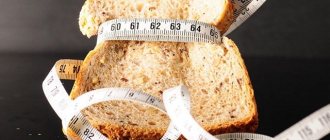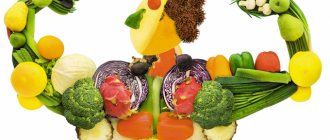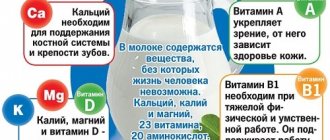Carbohydrates, like proteins and fats, are classified as macronutrients (from the Latin nutria - “nutrition”). These compounds of organic origin ensure full vital activity and perform functions necessary for humans. Functions of carbohydrates:
- Energy function. A person receives energy from food. A person receives about half of his required energy intake from foods rich in carbohydrate compounds. The brain is completely powered by carbohydrates. When oxidized, one gram of carbohydrates releases about 18 kJ of energy.
- Construction function. Nucleotides, nucleic acids contain carbohydrate compounds: ribose, deoxyribose. The structure of cell membranes contains carbohydrates. Glucose, in the process of oxidation (glycolysis), is converted into glucuronic acid, glucosamine, and other oxidation products. They are components of polysaccharides, complex proteins. This is how the construction function of carbohydrates is realized.
- Cumulative function. Skeletal muscles, liver, and other tissues store glycogen, a carbohydrate product.
- Protective function. The immune system contains high molecular weight carbohydrate substances called complex carbohydrates. They block the penetration of bacteria and viruses, and protect against mechanical influences.
- Osmotic function. Carbohydrates are able to regulate osmotic pressure. The level of osmotic pressure of the blood depends on the quantitative indicators of glucose.
- Receptor function. Cellular receptors glycoproteins contain carbohydrate compounds.
- Support. In plants and some animals, carbohydrate compounds are the supporting (skeletal) material.
- Regulatory. Fiber is able to regulate peristalsis.
- Genetic. Carbohydrate compounds are components of DNA and RNA.
- Specific. Affect nerve impulses and the formation of antibodies.
The biological functions of carbohydrates determine their necessity for a person to live a full life.
What are carbohydrates
Carbohydrates are substances of organic origin. They consist of carbonyl and hydroxyl groups. Carbon hydrates give their name to a class of carbohydrate compounds. Most of the organic matter on our planet in mass proportion consists of carbohydrate compounds.
Composition of carbohydrates
The structure of carbohydrates is heterogeneous. Carbohydrate compounds consist of carbon, hydrogen, oxygen. The general formula of carbohydrates looks like this: Cn(H2O)m. Oxygen and carbon form carbonyl groups, oxygen and hydrogen form hydroxyl groups. One molecule contains hydrogen and oxygen in a two to one ratio.
The individual elements that make up carbohydrates are called saccharides. The hydrolysis ability of carbohydrate compounds for low molecular weight substances is different. Therefore, they are divided into simple and complex in composition, and in terms of digestibility they are fast and slow carbohydrates.
Properties of carbohydrates
- Solid, transparent, white crystals, most of them have a sweet taste.
- They have a low melting and boiling point.
- The ability of carbohydrate compounds to dissolve in water depends on their mass and structure. Substances with a lower mass and simple structure dissolve in water better than carbohydrate compounds with a large mass and a branched structure.
- The simpler the carbohydrate compound, the sweeter it is.
- Monosaccharides are capable of fermentation under the influence of microorganisms: yeast, lactic bacteria and other substances.
- Carbohydrate compounds are hydrophilic, that is, the ability to bind water. Hence their high hygroscopicity, which underlies negative changes in food quality.
- Cooling polysaccharides breaks them down into monosaccharides.
- Helps synthesize nucleic acids.
- Increases blood glucose levels.
- Helps the body utilize fat.
- They are part of cells, tissues, intercellular fluids.
- They negatively affect tooth enamel and cause caries.
Types of carbohydrates
The classification of carbohydrates depends on their ability to decompose in an aqueous environment and form new substances - hydrolysis. Carbohydrates are:
- Simple - called monosaccharides.
- Difficult:
- disaccharide compounds,
- oligosaccharide compounds,
- polysaccharide compounds.
Monosaccharides are the simplest carbohydrate compounds, consisting of one unit and not capable of forming even simpler substances. Their synthesis is produced by green plants. They mix easily with water.
The most popular monosaccharide is glucose (C6H12O6). A large percentage of glucose is in grapes, grape juice, and honey. Fructose, a glucose isomer, also belongs to monosaccharides. If necessary, to get a good portion of glucose you need to eat apples, citrus fruits, peaches, watermelons, dried fruits, juices, compotes, jam, honey.
These are fast carbohydrates that have a high glycemic index and rapidly increase blood sugar levels. Monosaccharides can provide quick but short-lasting energy.
Disaccharides are complex substances of organic origin, bimolecular, that are broken down during the hydrolysis process.
These are different sugars. One of the common disaccharides: maltose or malt sugar (C12H22O11), which is a component of beer, kvass element. The disaccharide sucrose - table sugar - is filled with sugar, flour products, juices, compotes, and jam. Disaccharide lactose - milk sugar - dairy products.
Carbohydrates in the body: benefits and harms, sources of energy
How to calculate proteins, fats and carbohydrates
On the vastness of the World Wide Web you can find a huge variety of diets and nutritional rules. When tracking the main patterns, we can conclude that initially the cause of all troubles were fats, then they were replaced by carbohydrates. However, people who do not understand the role of these compounds in the body begin to abandon them completely, causing serious harm to their body.
Important! In the context of the number of calories entering the human body, carbohydrates occupy second place after fats (lipids). They account for about 60% of all energy needs. Therefore, the best way to lose weight is to reduce the amount of this nutrient in your diet.
Carbohydrate groups play a vital role in life; without their participation, the metabolic processes of proteins and fats are impossible. Feeling insufficient consumption of this nutrient, a person becomes lethargic, constantly tired, forgetful, and the body’s tone decreases. If you want carbohydrates to have an exclusively positive effect without causing weight gain, you must remember that they, like fats, are divided into healthy and harmful.
Important! In addition, carbohydrates are essential components in metabolic processes.
In this case, it would not be superfluous to note simple carbohydrates, since they are digested quickly and are not stored as fat, as complex carbohydrates are. They are also a very important source of energy, which the brain needs so much. For women, carbohydrates can significantly ease the first few days of menstruation, and are also involved in the synthesis of endorphin, the hormone of joy. The participation of carbohydrates in the normalization of liver function has been noted. They help in supplying blood with sugar and remove cholesterol.
Harmful carbohydrates are known as so-called “fast” carbohydrates. Due to the simplicity of their chemical composition, they are quickly and easily absorbed by the body. As a result, there is a sharp increase in blood sugar levels, which leads to a huge appetite, and excess sugars remain in the form of fat deposits.
This is evidenced by the fact that, for example, when you eat a bun or a small chocolate bar, the feeling of hunger again will not take long to occur. This feeling is false, because, despite the fact that the body has received a certain amount of calories, the brain still sends hunger signals. As a rule, to satisfy it, the same bun or chocolate is consumed. Carbohydrates of this variety have a predominantly sweet taste, stimulating the gain of unnecessary mass.
The role of carbohydrates in human life,
An important factor in this matter is the so-called “glycemic index” - a parameter of the influence of sugars on changes in the concentration of carbohydrates in the blood, namely glucose.
As for foods high in “fast” carbohydrates, these include the following:
- flour products made from wheat flour, such as white bread;
- honey, sugar, confectionery;
- sweet carbonated drinks, juices, cola;
- ketchup and mayonnaise;
- alcoholic drinks (mainly beer);
- fried potatoes.
As for healthy carbohydrates, the body takes relatively longer to digest them. During this time, the liver converts sugar into the necessary energy that both muscles and brain need. Based on this, it is recommended to give preference to complex carbohydrates during breakfast. This includes various cereals; muesli is an excellent choice. You can add bread, fruits and vegetables to them.
This breakfast will give you energy and vigor for a long time. In addition, it will provide the body with an abundance of vitamins and minerals. Complex carbohydrates form the basis of the so-called Mediterranean diet, which is rich in vegetables, fruits, olive oil, and whole grain products. You should not neglect pasta, since excess weight when consuming it is gained due to the use of sauces and gravies accompanying it.
What role do carbohydrates play in the body?
The importance of carbohydrates is very important for people.
- The main function of carbohydrates is to provide energy. During the breakdown of carbohydrate compounds, the energy released is spent for the main processes of cell metabolism. The oxidation of one gram of the substance produces four calories or almost 18 kJ.
- The construction of cell membranes, the production of nucleic acids, enzymes, and nucleotides cannot do without carbohydrate compounds.
- They act as anticoagulants - substances that inhibit blood clotting activity and prevent the formation of blood clots.
- They are a component of mucus that protects the gastrointestinal tract, respiratory organs, and genitourinary organs from viruses, bacteria, and physical influences.
- Digestive enzymes are stimulated due to carbohydrate compounds, which helps improve digestive processes and activate gastric peristalsis.
- Without carbohydrates, metabolic processes in the body cannot occur.
The listed properties explain why humans need carbohydrates.
The role of glycogen in physical activity
Glycogen is stored along with water in the ratio of 1 g of carbohydrates to 3 g of water. During exercise, it is broken down into glucose, which, together with fat, provides energy to the muscles.
During short-term high-intensity exercise (anaerobic) such as sprinting or lifting weights, the need for a huge amount of energy suddenly arises. In these cases, glycogen acts as the main fuel for the body, since only it can be broken down quickly enough, fat is consumed in small quantities.
During longer, low-intensity (aerobic) exercise, such as cycling, swimming or long-distance running, glycogen also acts as the main energy resource, but as its supply is depleted, more fat is used. Fat is not broken down quickly enough to continuously meet high energy demands and therefore the body's ability to withstand prolonged exercise is tied to its glycogen reserves. A sign of its depletion in working muscles is fatigue.
High glycogen levels at the beginning of exercise can prevent rapid fatigue. Thus, the amount of carbohydrates consumed determines the amount of accumulated glycogen, which in turn significantly affects our performance. When we eat something like fruit, cereal or bread, glucose quickly enters the bloodstream, ready to immediately provide energy to the brain, muscles or other body tissues that need it.
A low-carb diet is less effective at replenishing glycogen stores in the body. Its leakage is especially noticeable when there is no break between workouts. This may cause you to feel sluggish and lose interest in activities. In this case, it is necessary to take a break of several days so that the body can replenish its resources.
Glycogen reserves are replenished by consuming large amounts of carbohydrate foods. Good sources of carbohydrates are:
- bananas;
- bread;
- cereals;
- potato;
- rice;
- pasta.
By choosing whole versions of these foods, you also increase the amount of dietary fiber (fiber) in your diet. After training, it is necessary to replenish glycogen reserves, otherwise it will simply be impossible to perform at the maximum in the next workout. This may take up to 48 hours, and even longer if you are on a low-carb diet. Therefore, it is recommended to alternate between heavy and lighter workouts so that muscle glycogen stores can be properly restored.
In other words, the functions of carbohydrates in the human body are to effectively replenish glycogen stores in the muscles and liver. Glycogen is necessary for muscle contraction. If the body does not get enough carbohydrates or rest, glycogen levels inexorably decline, fatigue sets in, and the ability to work effectively decreases.
What foods contain carbohydrates
The table of carbohydrates will make it possible to understand how much of the substance the foods a person eats contain.
Carbohydrate-rich foods
| Product name | Mass fraction of carbohydrates (in grams) per 100 grams of product |
| Granulated sugar | 99 |
| Caramel, candy candies | 96 |
| Honey | 81 |
| Pastila, marshmallow | 81 |
| Marmalade | 79 |
| Gingerbread | 74 |
| Cookie | 69-74 |
| Strawberry jam | 74 |
| Rice flour | 80 |
| Rice groats | 74 |
| Corn flour | 72 |
| Corn grits | 71 |
| Drying bagels | 71 |
| Semolina | 70 |
| Buckwheat flour | 70 |
| Wheat flour | 65-70 |
| Pasta | 68-70 |
| Raspberry jam | 70 |
| Dates | 70 |
| Wheat groats | 68 |
| Pearl barley | 67 |
| Millet | 66 |
| Crackers | 67 |
| Rye flour | 62-66 |
| Oat bran | 66 |
| Raisin | 66 |
| Barley groats | 65 |
| Oatmeal | 65 |
| Cake | 49-63 |
| Waffles | 62 |
| Rice | 62 |
| Hercules | 62 |
| Buckwheat | 57-60 |
| Chocolate candies | 60 |
| wheat grain | 57-59 |
| Dried pears | 62 |
| Dried apples | 59 |
| Dried figs | 58 |
| Dried peach | 58 |
| Prunes | 57 |
| Condensed milk | 55-57 |
| Barley grain | 56 |
| Rye grain | 56 |
| Oat grain | 55 |
| Butter buns | 55 |
| Halva | 54 |
| Dried apricots | 53 |
| Dried apricots | 51 |
| loaf | 51 |
| Milk chocolate | 50 |
| bitter chocolate | 48 |
| Bread | 33-49 |
| Peas | 48 |
| Beans | 47 |
| Lentils, chickpeas, mung bean | 46 |
| Powdered milk | 39-50 |
| Alcoholic drinks | 20-35 |
| Cheesecakes in chocolate glaze | 32 |
| Pancakes | 31 |
| Garlic | 30 |
| Pistachios | 27 |
| Fried potatoes | 23 |
| Cashew | 22 |
| Rose hip | 22 |
| Bananas | 21 |
| Ice cream | 19-20 |
| Sweet corn | 19 |
| Syrniki | 18 |
| Ginger | 18 |
| Soybeans | 17 |
| Wheat bran | 16 |
| Peach, grape juice | 16 |
| Grapes, persimmon, mango, feijoa | 15 |
| Porridge | 15-20 |
Foods containing carbohydrates
Dairy
| Product name | Mass fraction of carbohydrates (in grams) per 100 grams of product |
| Acidophilus | 4 |
| Varenets | 4 |
| Yogurt | 8-14 |
| Kefir | 4 |
| Kumis | 5-6 |
| Milk | 5 |
| Buttermilk | 5 |
| Curdled milk | 4 |
| Ryazhenka | 4 |
| Cream | 4 |
| Sour cream | 3-4 |
| Cottage cheese | 3 |
| Adyghe cheese | 2 |
| Parmesan cheese | 1 |
| Sulguni cheese | 0.5 |
| Chees Feta | 4 |
| Gouda cheese | 2 |
| Processed cheese | 2-4 |
| Butter | 1 |
Nuts, seeds
| Product | Carbohydrate content (in grams) per 100 grams of product |
| Peanut | 10 |
| Walnut | 11 |
| Cedar nut | 13 |
| Cashew | 23 |
| Almond | 13 |
| Pistachios | 27 |
| Hazelnut | 9 |
| Sunflower | 10 |
| Sesame | 12 |
Fruits vegetables
| Product | Carbohydrate content (in grams) per 100 grams of product |
| Quince | 10 |
| Apricot | 9 |
| Cherry plum | 8 |
| A pineapple | 11 |
| Avocado | 2 |
| Orange | 8 |
| Watermelon | 6 |
| Eggplant | 5 |
| Banana | 21 |
| Cowberry | 8 |
| Swede | 8 |
| Basil | 3 |
| Grape | 15 |
| Cherry | 11 |
| Blueberry | 7 |
| Pomegranate | 14 |
| Pear | 10 |
| Grapefruit | 7 |
| Melon | 7 |
| Blackberry | 4 |
| Strawberries | 8 |
| Fresh figs | 12 |
| Zucchini | 5 |
| White cabbage | 5 |
| Broccoli | 7 |
| Brussels sprouts | 3 |
| Kohlrabi cabbage | 8 |
| Red cabbage | 5 |
| Cabbage | 2 |
| Savoy cabbage | 6 |
| Cauliflower | 4 |
| Potato | 16 |
| Kiwi | 8 |
| Cilantro | 4 |
| Cranberry | 4 |
| Watercress | 6 |
| Gooseberry | 9 |
| Lemon | 3 |
| Green onions | 3 |
| Onion | 8 |
| Leek | 6 |
| Raspberries | 8 |
| Mango | 15 |
| Mandarin | 8 |
| Carrot | 7 |
| Cloudberry | 7 |
| Sea kale | 3 |
| Nectarine | 11 |
| Sea buckthorn | 6 |
| Cucumber | 3 |
| Papaya | 11 |
| Parsnip root | 9 |
| bell pepper | 5 |
| Peach | 10 |
| Parsley | 8 |
| Pomelo | 10 |
| Tomatoes | 4 |
| Rhubarb | 3 |
| Radish | 3 |
| Radish | 7 |
| Turnip | 6 |
| Red rowan | 9 |
| Chokeberry | 11 |
| Salad | 2 |
| Beet | 9 |
| Celery greens | 2 |
| Celery root | 7 |
| Plum | 10 |
| Currant | 7-8 |
| Asparagus | 3 |
| Jerusalem artichoke | 13 |
| Pumpkin | 4 |
| Dill | 6 |
| Horseradish | 11 |
| Persimmon | 15 |
| Cherries | 11 |
| Blueberry | 8 |
| Garlic | 30 |
| Rose hip | 22 |
| Spinach | 2 |
| Sorrel | 3 |
| Apples | 10 |
Required amount of carbohydrates per day
Recommended daily intake:
- Eat a total of 5 to 9 servings of vegetables and fruits every day.
- Eat a total of 6 to 11 servings of breads, grains, starches, legumes and other complex carbohydrates each day.
- Limit your intake of refined sugars to no more than 10% of your total daily calorie intake.
Recommendations for daily carbohydrate intake:
| Physical activity | Carbohydrates |
| Sedentary lifestyle | Minimum 55% of total caloric intake, assuming adequate intake |
| Amateur athletes | Minimum 60% of total caloric intake, assuming adequate intake |
| Endurance athletes | 6-10 g per 1 kg of own weight |
| Athletes training for strength | 6-10 g per 1 kg of own weight |
In order to understand how many carbohydrates in grams you need, you should calculate the amount of carbohydrates from your daily calorie needs. On the labels of some products you can find a ready-made calculation of the amount of carbohydrates contained in one serving of the product, expressed as a percentage of daily calorie intake. As a rule, this value is given for a diet with a total volume of 2,000 kcal per day and the volume of carbohydrates in it is 300 g, which is equal to 60%. Based on these data, it is not difficult to calculate that with a daily intake of 2,500 kcal, the volume of carbohydrates will be 375 g (60%).
Now, having some understanding of their nature, it’s time to ask the next question: exactly how many grams of carbohydrates should you eat? We already know that this amount should be between 40% and 60% of your total daily calorie intake, and in the table below you can find more accurate values for this indicator.
The table shows the amount of carbohydrates (in grams) needed by people with a moderately active lifestyle depending on their body weight and the selected percentage (40, 50 or 60%) of carbohydrates to the total amount of calories consumed per day.
| Body weight (kg) | Daily calorie intake | 40% of daily calorie intake | 50% of daily calorie intake | 60% of daily calorie intake |
| 63.5 kg | 2604 kcal | 260 g | 326 g | 396 g |
| 68 kg | 2790 kcal | 279 g | 348 g | 419 g |
| 72.5 kg | 2976 kcal | 298 g | 372 g | 446 g |
| 77 kg | 3162 kcal | 316 g | 395 g | 474 g |
| 81.5 kg | 3348 kcal | 335 g | 418 g | 502 g |
| 86 kg | 3534 kcal | 353 g | 442 g | 530 g |
| 91 kg | 3720 kcal | 372 g | 465 g | 558 g |
Products without carbohydrates
A healthy menu should include slow carbohydrate compounds, that is, those that are absorbed gradually. It is better to prepare porridge from unprocessed cereals, using water rather than milk. Eat without sugar. You should not give up bran and muesli, because they are absorbed slowly and improve the functioning of the digestive system. Peas, beans, chickpeas, and lentils contain slow carbohydrate compounds, so they can be safely included in the diet. The lack of sweet taste will help identify foods that have a low glycemic index. A healthy menu should include low carbohydrate foods. These are vegetable, fruit, dairy products, herbs, nuts.
In addition to foods low in carbohydrates, there are foods that do not contain them at all.
- Meat: chicken, turkey, rabbit, veal, pork, lamb tenderloin.
- Liver: liver, kidneys, heart.
- Fish: river, sea, low-fat varieties.
- Seafood: shrimp, crab, squid.
- Vegetable oil: sunflower, olive, sesame.
- Mushrooms. Only porcini mushrooms and boletus mushrooms contain a small amount: no more than 1-2 grams per 100 grams of product.
- Cheese: Roquefort, Brie, Cheddar, Parmesan, Tilsiter and others.
- Alcoholic drinks: vodka, cognac, gin, brandy, rum.
Classification of carbohydrates
Carbohydrates are an important class of organic compounds that are found everywhere: in plant organisms, animal organisms and microorganisms. In plant organisms, carbohydrates account for 80-90%, in animal organisms – 1-5%, in microorganisms – 12-30%.
Rice. 2. Classification of carbohydrates
There are three main classes of carbohydrates: monosaccharides, oligosaccharides and polysaccharides (see Figure 2).
Regulation of carbohydrate metabolism
The following can be briefly described about carbohydrate metabolism in the human body. All mechanisms of breakdown, synthesis and absorption of carbohydrates, glucose and glycogen are regulated by various enzymes and hormones. This is a somatotropic, steroid hormone and, most importantly, insulin. It is he who helps glycogen overcome the cell membrane and penetrate into the cell.
It is impossible not to mention adrenaline, which regulates the entire phosphorolysis cascade. Acetyl-CoA, fatty acids, enzymes and other substances take part in the regulation of chemical processes for the absorption of carbohydrates. A shortage or excess of one or another element will certainly cause a malfunction in the entire system of absorption and processing of carbohydrates.
Reasons for deviations
The reasons for deviations in the regulation of glucose levels have various prerequisites:
- Hereditary disease – galactosemia. Symptoms of the pathology: weight loss, liver disease with yellowing of the skin, delayed mental and physical development, visual impairment. This disease often leads to death in the first year of life. This speaks volumes about the importance of carbohydrate metabolism in the human body.
- Another example of a genetic disease is fructose intolerance. The patient's kidneys and liver function are impaired.
- Malabsorption syndrome. The disease is characterized by the inability to absorb monosaccharides through the mucous membrane of the small intestine. Leads to impaired renal and hepatic function, diarrhea and flatulence appear. Fortunately, the disease can be treated by giving the patient a number of necessary enzymes that reduce the lactose intolerance characteristic of this pathology.
- Sandahoff disease is characterized by impaired production of enzymes A and B.
- Tay-Sachs disease develops as a result of impaired production of AN-acetylhexosaminidase in the body.
- The most famous disease is diabetes. With this disease, glucose does not enter the cells, since the pancreas has stopped secreting insulin. The same hormone without which the penetration of glucose into cells is impossible.
Most diseases accompanied by impaired glucose levels in the body are incurable. At best, doctors manage to stabilize the condition of patients by introducing missing enzymes or hormones into their bodies.
Relative sweetness of carbohydrates
When we eat simple carbohydrates, we experience sweetness. If we take the sweetness of sucrose as 100, then the sweetness of fructose will be 173, and the sweetness of glucose will be 74.3.
| Relative sweetness | Percentage of fructose | |
| Lactose | 16,0 | 9.2% |
| Galactose | 32,1 | 18.6% |
| Maltose | 32,5 | 18.8% |
| Glucose | 74,3 | 42.9% |
| Honey | 97,0 | 56.1% |
| Sucrose | 100,0 | 57.8% |
| Fructose | 173,0 | 100% |
What carbohydrates cleanse the body?
Our intestines must not only absorb nutrients from food well, but also regularly remove toxins. And carbohydrates help him with this.
As already mentioned, our body is equipped with various effective self-cleaning mechanisms. The main routes of elimination of harmful substances are through the lungs, liver, intestines (with stool), skin (with sweat) and kidneys (with urine).
However, for most people, the organs responsible for cleansing are constantly working in an intense mode and are under serious stress. For example, the liver, which is rightly called the main filter of the body, often has to deal with fatty foods, chemical food additives, alcohol, and a large number of medications. Constipation aggravates the process - the intestines do not remove waste, but instead absorb and accumulate toxins, which leads to self-poisoning of the body. To prevent this from happening, you should definitely include in your diet a sufficient amount of dietary fiber, which will restore motility and ensure daily bowel movements. These include fiber (cellulose), which forms the membranes of plant cells, and pectins.
On average, the daily carbohydrate requirement of healthy people is 400 g for men and 350 g for women . With dietary nutrition, especially against the background of obesity, the carbohydrate content in food can be reduced to 200 g. The physiological minimum, below which one should not fall, is about 100 g of carbohydrates per day.
Connecting these cells to each other. Fiber stimulates intestinal motor function and bile secretion, forms feces, creates a feeling of fullness, and helps remove cholesterol from the body. Pectins absorb harmful substances, reduce putrefactive processes in the intestines, and promote the healing of its mucous membrane. These properties of pectins are widely used in the treatment of diseases of the gastrointestinal tract. Fruits, berries and some vegetables (beets, carrots, parsley) are rich in pectins.
A long-term lack of “ballast” substances in the diet leads to constipation, contributes to the occurrence of diverticula, polyposis, hemorrhoids and even colon and rectal cancer, and is also one of the risk factors in the development of atherosclerosis, diabetes mellitus, and cholelithiasis. However, excessive consumption of dietary fiber is also harmful, since it leads to bloating, increased gas formation with flatulence, and deterioration in the absorption of proteins, fats, calcium, iron and other microelements.
Fiber content in various foods
Below is the amount of fiber (g) per 100 g of product.
- Very high (more than 1.5) - Wheat bran, beans, nuts, oatmeal, fresh mushrooms, raspberries, strawberries, blueberries, black, white and red currants, cranberries, gooseberries, prunes.
- High (1–1.5) - Buckwheat, pearl barley and barley, Hercules oat flakes, split peas, potatoes, carrots, white cabbage, green peas, eggplants, sweet bell peppers, pumpkin, sorrel, quince, oranges, lemons , cowberry.
- Moderate (0.6–0.9) - Rye bread, millet, green onions, cucumbers, beets, tomatoes, radishes, cauliflower, melon, apricots, pears, peaches, apples, bananas, tangerines.
- Low (0.3–0.5) - Rice, zucchini, lettuce, watermelon, cherries, plums, cherries.
Products enriched with fiber: rye bran is very rich in B vitamins, magnesium, potassium, and fiber. They are added to flour products, cereals, soups, compotes, and are also used to prepare a healing drink - bran decoction. Bran is included in diets for hypertension, diabetes, atherosclerosis, obesity, constipation, and cholelithiasis. Particularly useful are non-carbohydrate bran washed from starch.
Protein-bran bread with an increase in protein content and a decrease in the amount of carbohydrates (up to 23% and 16%, respectively) is a dietary product. This bread contains a lot of B vitamins, microelements and fiber. But at the same time, its energy value is only 0.76 MJ (180 kcal). Protein-bran bread is included in diets for diabetes, obesity and other diseases associated with metabolic disorders.
Doctor's bread with bran is also characterized by a high content of B vitamins, microelements and fiber. Included in diets for constipation, atherosclerosis, coronary heart disease and cholelithiasis.
Salt-free bread made from rye flour contains only 52 mg of sodium per 100 g of product (instead of 300–400 mg in other types of bread). It is included in diets for hypertension, circulatory disorders, and kidney diseases.
Today we consume on average 33% less fiber than we did a hundred years ago.
Restoration of carbohydrate metabolism
How to restore carbohydrate metabolism in the human body? It all depends on which direction the glucose level has shifted.
If a person has hyperglycemia, then he is prescribed a diet to reduce fat and carbohydrates in the diet. And with hypoglycemia, that is, low glucose levels, on the contrary, it is prescribed to consume more carbohydrates and proteins.
It should be understood that it is quite difficult to restore carbohydrate metabolism in the human body. Diet alone is usually not enough; often the patient must undergo a course of treatment with medications: hormones, enzymes, and so on. For example, with diabetes, the patient must receive injections of the hormone insulin for the rest of his life. Moreover, the dosage and regimen of the drug are prescribed individually depending on the patient’s condition. Indeed, in general, treatment is aimed at eliminating the cause of carbohydrate metabolism disorders in the human body, and not just at its temporary normalization.
Stages of carbohydrate breakdown
Processing of food, the main component of which is the carbohydrate component, occurs in different parts of the digestive tract.
— the beginning of splitting occurs in the oral cavity. During the act of chewing, food is processed by the salivary enzyme pitalin (amylase), which is synthesized by the parotid glands. It helps the huge starch molecule break down into smaller polymers.
- since food is in the oral cavity for a short time, it requires subsequent processing in the stomach. Once in the stomach cavity, carbohydrate products are mixed with the secretion of the pancreas, namely pancreatic amylase, which is more effective than oral amylase, and therefore after 15-30 minutes, when chyme (semi-liquid incompletely digested stomach contents) from the stomach reaches In the duodenum, almost all carbohydrates are already oxidized to very small polymers and maltose (a disaccharide, two connected glucose molecules).
- from the duodenum, a mixture of polysaccharides and maltose continues its amazing journey to the upper intestines, where their final processing is carried out by the so-called enzymes of the intestinal epithelium. Enterocytes (cells that line the microvilli of the small intestine) contain the enzymes lactase, maltase, sucrase and dextrinase, which carry out the final processing of disaccharides and small polysaccharides into monosaccharides (this is already one molecule, but not yet glucose). Lactose breaks down into galactose and glucose, sucrose into fructose and glucose, maltose, like other small polymers, into glucose molecules, and it instantly enters the bloodstream.
— from the bloodstream, glucose enters the liver and, subsequently, glycogen is synthesized from it (a polysaccharide of animal origin, performs a storage function, and is simply necessary for the body when it needs to quickly obtain a large amount of energy).
What are the dangers of excess carbohydrates for the body?
A large amount of carbohydrates in food leads to metabolic disorders and diseases . With a balanced diet, up to 30% of food carbohydrates can turn into fats. With an excess of carbohydrates, this percentage increases significantly, which inevitably leads to the accumulation of excess weight. Therefore, when treating obesity, it is important to limit the consumption of easily digestible carbohydrates.
Systematic excessive consumption of carbohydrates with a lack of dietary fiber contributes to the onset and progression of diabetes mellitus , especially with a hereditary predisposition to it. This is due to overload and then depletion of pancreatic cells, which produce insulin necessary for the absorption of glucose. Disorders of fat metabolism, characteristic of atherosclerosis, can also be triggered by excessive consumption of easily digestible carbohydrates, especially sucrose. So it’s much healthier to get the carbohydrates your body needs from vegetables, fruits, grains and legumes.










